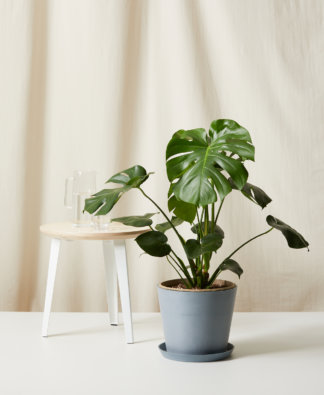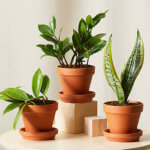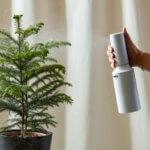How to care for your Philodendron
Use these instructions to care for a Philodendron. This guide will tell you how to water a Philodendron; its light, temperature, humidity preferences and any additional care it might need to help it grow.
Fuzzy Petiole
Your Philodendron prefers indirect bright light, but the Philodendrons can adapt to lower light. These plants can only tolerate some direct sun in the morning; extended periods of direct light can burn the foliage.
Water your Philodendron when the soil volume is 50-75% dry. Water thoroughly until water comes out of the drainage holes, and be sure to empty the saucer of any excess water. These plants are sensitive to overwatering—if the soil remains constantly wet, the roots will rot.
Average household humidity is fine for your Philodendron, but higher humidity encourages larger leaves. Your plants will benefit from a pebble tray or adding a humidifier.
Your Philodendron will grow well in temperatures between 65-80°F. Keep away from drafts, especially during the winter months.
Feed your Philodendron monthly in the spring and summer with a general-purpose fertilizer. No fertilizer is needed in the fall and winter months when the plants are dormant. Always fertilize on moist soil, never dry, as it can burn the roots.
Philodendrons are toxic to humans and pets if ingested.
This plant is easily propagated through cuttings to make new plants or help fill out the mother plants. Since these are climbers, you can add plant stakes or a moss pole to encourage larger leaf growth.
Philodendron Birkin
Your Philodendron Birkin prefers bright, indirect light. It can survive in medium light conditions, but growth may slow. The variegation on its leaves will be more pronounced in higher light. Do not put it in full, direct sunlight as it will burn the foliage.
Water your Philodendron when the top 50-75% of soil is dry. Water until liquid flows through the drainage hole at the bottom of the pot and discard any water that has accumulated in the saucer.
Normal household humidity is fine for your Philodendron Birkin, but higher humidity encourages larger leaves. Your plant will benefit from regular misting.
Your plant will grow well in temperatures between 70-80 degrees during the day and above 55 degrees at night. Keep it away from drafts, especially during the winter months.
Feed once a month during spring and summer with a liquid fertilizer for indoor plants. Feed every other month during the fall and winter.
Philodendron leaves are toxic to pets and humans. Typically, ingestion will result in swelling of the lips and tongue, and stomach irritation with possible vomiting.
Trim out any dead, discolored, damaged, or diseased leaves and stems as they occur. Use clean, sharp scissors to avoid tearing or bruising the stems. Snip stems close to soil level. Wash the leaves frequently to prevent dust from clogging its pores.
Philodendron Brandi
Your Philodendron Brandi can survive in low light conditions, but grows faster and produces more leaves in medium or bright indirect light. The silver coloring will be more pronounced in higher light. Do not place in direct sunlight, as the sun will burn the foliage.
Water your Philodendron when the top 50%-75% of the soil is dry. Water until liquid flows through the drainage hole at the bottom of the pot and discard any water that has accumulated in the saucer.
Basic household humidity is fine for your Philodendron Brandi, but higher humidity encourages larger leaves. Your plant will benefit from the occasional misting.
Your plant will grow well in temperatures between 70-80 degrees during the day and above 55 degrees at night. Keep it away from drafts, especially during the winter months.
Feed once a month during spring and summer with a liquid fertilizer for indoor plants.
Philodendron leaves are toxic to pets and humans. Typically, ingestion will result in swelling of the lips and tongue, and stomach irritation with possible vomiting.
Trim out any dead, discolored, damaged, or diseased leaves and stems as they occur. Use clean, sharp scissors to avoid tearing or bruising the stems. Snip stems just above a leaf node. Wash the leaves frequently to prevent dust from clogging its pores.
Philodendron Brasil
The Philodendron Brasil can survive in low light conditions, but grows faster and produces more leaves in medium or bright indirect light. The variegation will be more pronounced in higher light. Do not put it in direct sunlight since the sun will burn the foliage.
Water your Philodendron when the top 50%-75% of the soil is dry. Water until liquid flows through the drainage hole at the bottom of the pot and discard any water that has accumulated in the saucer.
Basic household humidity is fine for your Philodendron Brasil, but higher humidity encourages larger leaves. Your plant will benefit from the occasional misting.
Your plant will grow well in temperatures between 70-80 degrees during the day and above 55 degrees at night. Keep it away from drafts, especially during the winter months.
Feed once a month during spring and summer with a liquid fertilizer for indoor plants.
Philodendron leaves are toxic to pets and humans. Typically, ingestion will result in swelling of the lips and tongue, and stomach irritation with possible vomiting.
Trim out any dead, discolored, damaged, or diseased leaves and stems as they occur. Use clean, sharp scissors to avoid tearing or bruising the stems. Snip stems just above a leaf node. Wash the leaves frequently to prevent dust from clogging its pores.
Philodendron Heartleaf
The Philodendron Heartleaf can cope with low light conditions, but grows faster and produces more leaves bright indirect light. Do not put it in direct sunlight–the sun will burn the foliage.
Water your Philodendron when the top 50%-75% of the soil is dry. Water until liquid flows through the drainage hole at the bottom of the pot and discard any water that has accumulated in the saucer.
Basic household humidity is fine for this Philodendron, but higher humidity encourages larger leaves. Your plant will benefit from the occasional misting.
Your Philodendron Heartleaf will grow well in temperatures between 65-80 degrees during the day and above 55 degrees at night. Keep it away from drafts, especially during the winter months.
Feed once a month during spring and summer with a liquid fertilizer for indoor plants.
Philodendron leaves are toxic to pets and humans. Typically, ingestion will result in swelling of the lips and tongue, and stomach irritation with possible vomiting.
Trim out any dead, discolored, damaged, or diseased leaves and stems as they occur. Use clean, sharp scissors to avoid tearing or bruising the stems. Snip stems just above a leaf node. Wash the leaves frequently to prevent dust from clogging its pores. If you wish to propagate, take stem tip cuttings during the Spring or early Summer and place the stem in water or moist soil and they should root quite easily.
Philodendron Hope Selloum
Your Philodendron Hope Selloum prefers bright, indirect light. It will, however, survive in lower light and the leaves will turn a darker green. Direct sun or too much light will burn or fade the leaves.
Water your Philodendron when the top 50%-75% of the soil is dry. Water until liquid flows through the drainage hole at the bottom of the pot and discard any water that has accumulated in the saucer.
The Philodendron Hope Selloum has thinner leaves than many of its relatives and requires more humidity to flourish. Mist your plant regularly especially during the drier winter months.
Your Philodendron Hope Selloum likes warm temperatures above 55 degrees. Keep them away from drafts and open doors, especially during the winter.
Fertilize monthly during the spring and summer with a balanced, water-soluble fertilizer diluted to half the recommended strength.
Philodendron leaves are toxic to pets and humans. Typically, ingestion will result in swelling of the lips and tongue, and stomach irritation with possible vomiting.
Prune your Philodendron Hope Selloum with sharp scissors to control its size and shape. You can remove entire leaves be cutting them off at the base of the leaf stem. Be sure to wear gloves when pruning and wash your hands and tools when finished—you don’t want to get the sap in your eyes or mouth. Always clean dead or decaying leaves from the soil and dust it once a month to keep your plant healthy.
Philodendron Lemon Lime
The Philodendron Lemon Lime can cope with low light conditions, but grows faster and produces more leaves bright indirect light. Do not put it in direct sunlight–the sun will burn the foliage.
Water your Philodendron when the top 50%-75% of the soil is dry. Water until liquid flows through the drainage hole at the bottom of the pot and discard any water that has accumulated in the saucer.
Basic household humidity is fine for this Philodendron, but higher humidity encourages larger leaves. Your plant will benefit from the occasional misting.
Your Philodendron Lemon Lime will grow well in temperatures between 65-80 degrees during the day and above 55 degrees at night. Keep it away from drafts, especially during the winter months.
Feed once a month during spring and summer with a liquid fertilizer for indoor plants.
Philodendron leaves are toxic to pets and humans. Typically, ingestion will result in swelling of the lips and tongue, and stomach irritation with possible vomiting.
Trim out any dead, discolored, damaged, or diseased leaves and stems as they occur. Use clean, sharp scissors to avoid tearing or bruising the stems. Snip stems just above a leaf node. Wash the leaves frequently to prevent dust from clogging its pores. If you wish to propagate, take stem tip cuttings during the Spring or early Summer and place the stem in water or moist soil and they should root quite easily.
Philodendron Little Hope
Your Philodendron Little Hope prefers bright, indirect light. It will, however, survive in lower light and the leaves will turn a darker green. Direct sun or too much light will burn or fade the leaves.
Water your plant when the top 50-75% of soil is dry. Water the plant until water flows into the saucer, then pour out any excess. Don’t allow the pot to stand in water, as this will cause root rot.
This tropical plant prefers a bit of humidity and will benefit from regular weekly misting.
Your Philodendron Little Hope likes warm temperatures above 55 degrees. Keep it away from drafts and open doors, especially during the winter.
Fertilize monthly during the spring and summer with a balanced, water-soluble fertilizer diluted to half the recommended strength.
Philodendron leaves are toxic to pets and humans. Typically, ingestion will result in swelling of the lips and tongue, and stomach irritation with possible vomiting.
Always remove any decaying plant material from the soil to keep your plant healthy and happy.
Philodendron Micans Velvet
Your Philodendron Micans Velvet can survive in low light conditions, but grows faster and produces richer coloring in bright indirect light. This plant can only tolerate some direct sun in the morning; extended periods of direct light can burn the foliage.
Water your Philodendron Micans Velvet when the soil volume is 50-75% dry. Water thoroughly until water comes out of the drainage hole, and be sure to empty the saucer of any excess water. This plant is sensitive to overwatering—if the soil remains constantly wet, the roots will rot.
Average household humidity is fine for your Philodendron Micans Velvet but higher humidity encourages larger leaves. Your plant will benefit from a pebble tray or adding a humidifier, but avoid directly misting the leaves.
Your Philodendron Micans Velvet will grow well in temperatures between 65-80°F. Keep away from drafts, especially during the winter months.
Feed your Philodendron Micans Velvet monthly in the spring and summer with a general-purpose fertilizer. No fertilizer is needed in the fall and winter months when the plant is dormant. Always fertilize on moist soil, never dry, as it can burn the roots.
This plant is toxic to pets and humans if ingested.
Trim out any dead, discolored, or damaged leaves using clean, sharp scissors. As the plant ages, the older leaves will naturally turn yellow or brown and fall off. This philodendron is easily propagated through cuttings to make new plants or help fill out the mother plant.
Philodendron Pink Princess
Your Philodendron Pink Princess can survive in low light conditions, but grows faster and produces more variegation in bright indirect light. The plant can only tolerate direct sun in the morning; extended periods or exposure to the harsh midday sun will burn the foliage.
Water your Philodendron Pink Princess when the soil is 75% dry. Water thoroughly until water comes out of the drainage holes, and be sure to empty the saucer of any excess water. This plant is sensitive to overwatering. If the soil remains constantly wet, the roots will rot.
Basic household humidity is fine for your Philodendron Pink Princess, but higher humidity encourages larger leaves. Your plant will benefit from occasional misting or adding a humidifier.
Your plant will grow well in temperatures between 65-80°F degrees. Avoid exposing the plant to temperatures below 60°F, and keep it away from drafts, especially during the winter months.
Feed your Philodendron Pink Princess monthly in the spring and summer with a basic houseplant food diluted to half the recommended strength. If the leaves curl or the edges turn brown, it may be getting too much fertilizer. No fertilizer is needed in the fall and winter months.
This plant is toxic to pets and humans. Typically, ingestion will result in swelling of the lips and tongue, and stomach irritation with possible vomiting.
Trim out any dead, discolored, or damaged leaves using clean, sharp scissors. As the plant ages, the older leaves will naturally turn yellow or brown and fall off. Wash the leaves frequently to prevent dust from setting on the surface. Your Philodendron Pink Princess is a vining plant, so consider providing a trellis for it to climb on.
Philodendron Prince of Orange
Your Philodendron Prince of Orange can survive in low light conditions but will grow faster and produce more leaves in medium or bright indirect light. Do not place it in direct sunlight—the sun will burn the foliage.
Water your Philodendron Prince of Orange when the soil volume is 75% dry. Water thoroughly until water comes out of the drainage holes, and be sure to empty the saucer of any excess water. This plant is sensitive to overwatering. If the soil remains constantly wet, the roots will rot.
Average household humidity is fine for your Philodendron Prince of Orange, but higher humidity encourages larger leaves. Your plant will benefit from occasional misting.
Your Philodendron Prince of Orange will grow well in temperatures between 65-80°F during the day and anywhere above 55°F at night. Keep it away from drafts, especially during the winter months.
Feed your Prince of Orange monthly in the spring and summer with a basic houseplant food diluted to half the recommended strength. If the leaves curl or the tips turn brown, it may be getting too much fertilizer. No fertilizer is needed in the fall and winter months.
This plant is toxic to pets and humans. Typically, ingestion will result in swelling of the lips and tongue, and stomach irritation with possible vomiting.
As the plant ages, the oldest leaves near the bottom will fall off or turn brown. Use clean, sharp plant snips to avoid tearing or bruising the stems. Trim out any dead, discolored, or damaged leaves. Wash the leaves frequently to prevent dust from setting on the surface. Your Philodendron Prince of Orange loves to lean towards the light, so rotating it every week or so will help it stay full on all sides.
Philodendron Shangri La
Your Philodendron Shangri La prefers bright, indirect light—placing it near an east-facing window is ideal. It will survive in lower light, but the leaves will turn a darker green. Direct sun will fade the leaves.
Water your Philodendron when the top 50-75% of soil is dry. Water until liquid flows into the saucer, then pour out any excess. Don’t allow the pot to stand in water, as this will cause root rot.
This tropical plant prefers a bit of humidity and will benefit from regular misting or the use of a humidifier.
Your Philodendron Shangri La prefers temperatures above 55 degrees. Keep it away from drafts and open doors, especially during the winter.
Feed once a month during spring and summer with a liquid fertilizer for indoor plants.
Philodendron leaves are toxic to pets and humans. Typically, ingestion will result in swelling of the lips and tongue, and stomach irritation with possible vomiting.
Always remove any decaying plant material from the soil to keep your plant healthy and happy.
Philodendron Silver Sword
Your Philodendron prefers indirect bright light, but the Philodendrons can adapt to lower light. These plants can only tolerate some direct sun in the morning; extended periods of direct light can burn the foliage.
Water your Philodendron when the soil volume is 50-75% dry. Water thoroughly until water comes out of the drainage holes, and be sure to empty the saucer of any excess water. These plants are sensitive to overwatering—if the soil remains constantly wet, the roots will rot.
Average household humidity is fine for your Philodendron, but higher humidity encourages larger leaves. Your plants will benefit from a pebble tray or adding a humidifier.
Your Philodendron will grow well in temperatures between 65-80°F. Keep away from drafts, especially during the winter months.
Feed your Philodendron monthly in the spring and summer with a general-purpose fertilizer. No fertilizer is needed in the fall and winter months when the plants are dormant. Always fertilize on moist soil, never dry, as it can burn the roots.
Philodendrons are toxic to humans and pets if ingested.
This plant is easily propagated through cuttings to make new plants or help fill out the mother plants. Since these are climbers, you can add plant stakes or a moss pole to encourage larger leaf growth.
Philodendron Velvet
Your Philodendron Velvet can adapt to lower light conditions, however, when placed in bright indirect light, it grows faster and produces more leaves. Avoid direct sunlight–the sun will burn the foliage.
Water your Philodendron when the top 50%-75% of the soil is dry. Water until liquid flows through the drainage hole at the bottom of the pot and discard any water that has accumulated in the saucer.
Basic household humidity is fine for your Philodendron Velvet, but higher humidity will encourage larger leaves. Your plant will benefit from an occasional misting.
Your Philodendron Velvet will grow well in temperatures between 65-80 degrees during the day and above 55 degrees at night. Keep it away from drafts, especially during the winter months.
Feed your Philodendron Velvet monthly in the spring and summer with a basic houseplant food diluted to half the recommended strength. No need to fertilize in the fall and winter months, when growth naturally slows.
Philodendron leaves are toxic to pets and humans. Typically, ingestion will result in swelling of the lips and tongue, with stomach irritation and possible vomiting.
Trim any dead, discolored, damaged, or diseased leaves and stems as they occur. Use clean, sharp scissors to avoid tearing or bruising the stems. Snip stems just above a leaf node. Wash the leaves frequently to prevent dust from clogging its pores. If you wish to propagate, take stem tip cuttings during the spring or early summer and place the stem in water or moist soil and they should root quite easily.
Philodendron White Knight
Your Philodendron White Knight can survive in low light conditions, but grows faster and produces more white variegation in bright indirect light. The plant can only tolerate some direct sun in the morning; extended periods of direct light can burn the foliage.
Water your Philodendron White Knight when the soil is 50-75% dry. Water thoroughly until water comes out of the drainage holes, and be sure to empty the saucer of any excess water. This plant is sensitive to overwatering. If the soil remains constantly wet, the roots will rot.
Basic household humidity is fine for your Philodendron White Knight but higher humidity encourages larger leaves. Your plant will benefit from a pebble tray or adding a humidifier.
Your Philodendron White Knight will grow well in temperatures between 65-80°F. Keep away from drafts, especially during the winter months.
Feed your Philodendron White Knight monthly in the spring and summer with a general-purpose fertilizer. No fertilizer is needed in the fall and winter months when the plant is dormant. Always fertilize on moist soil, never dry as it can burn the roots.
This plant is toxic to pets and humans if ingested.
Trim out any dead, discolored, or damaged leaves using clean, sharp scissors. As the plant ages, the older leaves will naturally turn yellow or brown and fall off. Your Philodendron White Knight is a vining plant, so consider providing a trellis or moss pole for it to climb on.
Philodendron Xanadu
Your Philodendron prefers medium to bright indirect light. It can adapt to low light, but growth may slow.
Water your Philodendron when the top 50%-75% of the soil is dry. Water until liquid flows through the drainage hole at the bottom of the pot and discard any water that has accumulated in the saucer.
Your Philodendron Xanadu will tolerate the level of humidity found in most homes, but high humidity promotes lush growth and shiny foliage, so it is a good idea to mist the plant regularly.
Your Philodendron Xanadu likes warm temperatures above 55 degrees. Keep them away from drafts and open doors, especially during the winter.
Fertilize monthly during the spring and summer with a balanced, water-soluble fertilizer diluted to half the recommended strength. Never apply fertilizer to dry soil, always make sure soil is damp before applying plant food.
Philodendron Xanadu leaves are toxic to pets and humans. Typically, ingestion will result in swelling of the lips and tongue, and stomach irritation with possible vomiting.
Yellow leaves on your Xanadu occur naturally as new growth comes in or if it is acclimating to a new spot in your home. Remove these yellow dead or dying leaves regularly by snapping them off where the leaf stem touches the primary stem or the soil surface. It is also a good idea to periodically look between the dense foliage and remove the dried leaf husks left behind when a new leaf is produced. Regularly clearing away this dead organic material prevents mold, fungus, and worst of all Fungus Gnats.




